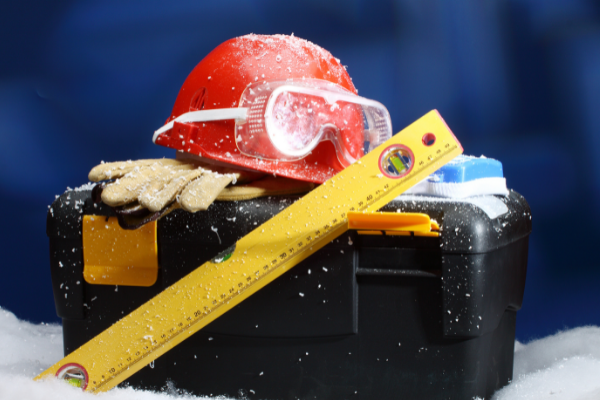
5 Steps to Safer New Year!
Did you know, according to data collected by OSHA, in 2020, private industry employers reported 2.7 million nonfatal workplace injuries and illnesses? In addition, statistics from the Bureau of Labor Statistics show manufacturing, transportation, and food production workers have the highest rates for days away from work due to injury and illness. By creating a safe work environment, workers are better protected from injury and illness, which results in reduced absenteeism, lower turnover, and increased productivity. Therefore, Safety Plus has created 5 steps to help workers enjoy a safe and productive new year!
1. Identify Risks
A safer workplace begins with identifying risks and anticipating potential hazards. Using a data-driven approach to identify risks will help narrow focus on areas that most need attention in the workplace. Managers and safety professionals can use primary or secondary data as a starting point to understand risks based on industry and occupation. Additionally, tools like safety management software can be an invaluable resource packed full of primary data to help identify leading indicators specific to a company, department, or job type. Safety management software also empowers managers by helping to predict concerns before a potential injury occurs.
Once a safety system is implemented to identify risks, it will be easier to develop a plan to train employees on workplace hazards and implement a corrective action process to ensure hazards are addressed before an incident occurs.
2. Learn & Understand Compliance
OSHA is the branch of the United States Department of Labor and government agency, "created by Congress to ensure safe and healthful working conditions for workers by setting and enforcing standards." (OSHA, 2021)
It is OSHA's responsibility to keep compliance standards up to date, and they have the authority to impose or increase fines for non-compliance. For example, in 2017, OSHA shook up the construction industry by developing requirements to enhance protection by limiting worker exposure to silica. OSHA's new regulation required construction companies to offer medical exams, provide respirators and implement written exposure plans. According to Bloomberg Law, the Respirable Crystalline Silica in Construction Standard enforced by OSHA cost a Virginia-based construction company a proposed fine of $304,130. All of which could have been avoided if the company had learned, understood, and followed the new Silica Rule.
It's also worth noting, in 2021, OSHA increased penalties for serious and non-serious, repeated, and willful workplace safety violations.
The point is, when safety requirements are violated, companies can suffer potentially serious consequences. Therefore, it's recommended that managers and safety professionals learn, understand and stay current on regulatory health and safety compliance. Our CSP at Safety Plus recommends visiting the OSHA website regularly to research safety standards, requirements, and how to remain in compliance. Also, OSHA fact sheets are a great resource to learn about compliance, in addition to subscribing to safety newsletters from industry resources such as OSHA’s Quicktakes, the CDC, the EPA, and by following Safety Plus on LinkedIn. Finally, local business associations are also a great resource to learn and stay current on compliance.
3. Develop or Update Policies, Programs & Processes
The next step towards a safe new year involves policies, programs, and processes. Based on identified risks from step one and compliance standards from step two, it's now time to develop policies, programs, and processes or update current ones as necessary. By developing and updating safety documents, expectations and guidelines are established for the health and safety program while also creating a company culture that values safety.
When developing or updating these documents, employee’s responsibilities should be clear and concise along with procedures to follow to remain healthy and stay safe. As a best practice, policies and processes should be well documented, which will help limit the potential for misinterpretation. In addition to having updated policies and processes, some safety regulations also require written plans. Below are just a few examples of safety plans and programs that are required due to regulation:
• Emergency Action Plans
• Electrical Safety
• Fire Prevention Plans
• Hearing Conservation Plans
• Hazard Communication Program
• Respiratory Protection Program
• Bloodborne Pathogens Exposure Plan
• Trenching and Excavation Safety
4. Educate Employees
Education and training are invaluable tools for employers and workers, and many OSHA standards also require some form of education and training. Safety education and training play a crucial role in keeping worker safety top of mind while also limiting employer liability. Therefore, training sessions should be consistently held during worker’s employment. At a minimum, training should occur whenever a new hire is onboarded, new processes are introduced, or new equipment is implemented. Refresher training should also occur as required by OSHA.
In addition, posters and signage should be displayed as a reminder of safety procedures and priorities. Employee handbooks should also include workplace safety procedures. For further guidance on safety education and training, contact Safety Plus.
5. Enforce & Evaluate your Program
Once your safety plan is complete, ensure key stakeholders are on board with enforcing the plan. If management is not on board, it will be tough to implement any changes. Routine safety audits and annual training sessions are great ways to enforce safety policies, programs, and processes. It is also essential to evaluate the success of programs regularly by reviewing accident rates and tracking program participation.
This concludes the 5 steps to help launch your safety plan in 2022. For more detailed information on any of the topics of this article, for a free evaluation, or to request a quote for safety program management, contact us at Safety Plus.
References:
https://www.osha.gov/aboutosha
.png)